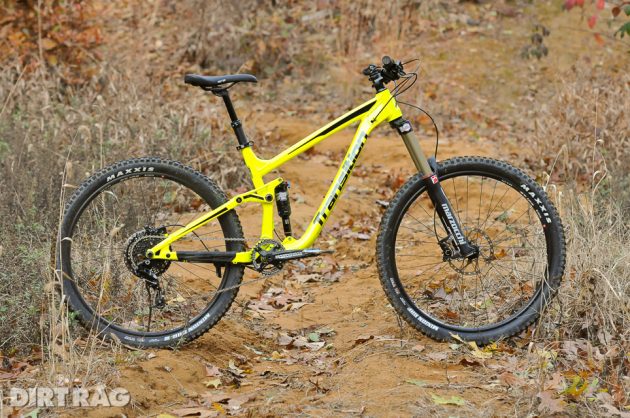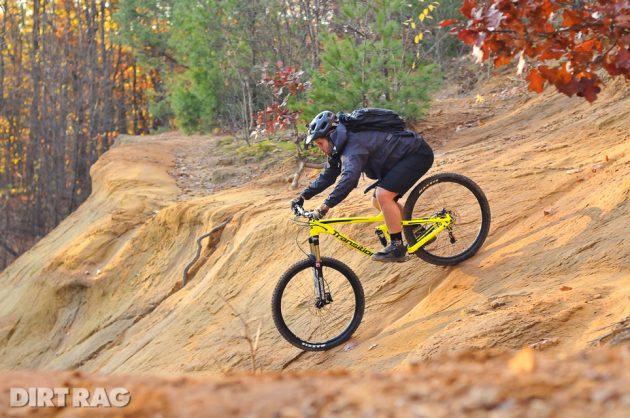Review: Transition Patrol 4
Originally posted on May 2, 2016 at 7:00 am
This is our third annual roundup of trail bikes that aren’t priced to the stratosphere. We could call them affordable, budget, real-world, blue-collar or college-fund-friendly, but someone would take offense at our assumption of disposable income level. It doesn’t really matter though. These are great bikes for the price, and we’ll leave it up to you about what to spend. Each bike was hand picked, not just for its price, but its components, geometry and modern features. From Issue #189.
Get an overview of all of the bikes in this test, here, and keep an eye out for full reviews of each.

Tester: William Kirk
Age: 32, Height: 5’ 9”, Weight: 185 lbs., Inseam: 31”
Price: $2,999
Sizes: S, M (tested), L
Last year Transition Bikes went through a major facelift, redesigning many models to use a Horst Link suspension design, dubbed the Giddy Up Link. The 155 mm travel Patrol is Transition’s longest-travel trail bike, aimed at riders who put an emphasis on going downhill quickly and funly.

The spec on the Patrol 4 consists of a very solid array of components. Rear suspension is handled by the RockShox Monarch RT DebonAir while a Marzocchi 350 R handles things up front. A tight-and-wide Race Face cockpit paired with the Shimano Deore brakes keeps the steering fast and the stopping quick. Traction is excellent, thanks to 2.3 inch Maxxis Minon DHF/DHR tires mounted to WTB i25 rims. The Patrol is equipped with a 1×10 SRAM/RaceFace drivetrain with a 42 tooth Hive cog and also includes the KS eTen Integra (100 mm) dropper post.

My first ride on the Patrol was spent on our local freeride trails. The variety of drops allowed me to quickly set up the Patrol’s suspension to my liking.
Setup was mostly problem free until I began to tinker with the Marzocchi 350 R fork. Out of the box it lacks sufficient rebound damping; it’s not un-ride- able, but heavier riders will have to deal with fast rebound speeds.

In the woods, it was immediately apparent the Patrol likes to get moving fast, where its relaxed geometry excels at remaining stable. Larger drops are easily managed by the Patrol’s plush suspension, and the cockpit puts me in a great position for railing berms and popping off of lips. The trail manners of the Patrol rewards a rider who is actively looking to get the bike into the air whenever possible.

On rough terrain where repeated hits were commonplace, the Patrol shined. This isn’t at all surprising given that it was developed with some of the most difficult enduro courses in mind. The long top tube and wheelbase keep the bike feeling very well-planted when hitting rock gardens at speed.

When the trail gets steep and rough, the 65 degree head angle provides excellent stability resulting in more speed and confidence on the trail. On multiple occasions I mistimed a line and smacked the rear end of the Transition harshly. The Horst Link suspension system does an excellent job of soaking up those misjudgments and remains active when required.

Going up, the Transition pedals fairly well in the fully open shock position, but I found it was best to flip the RockShox lever to “trail” in order to get a good balance of traction and maximum pedaling efficiency. The Maxxis tires found best traction in a comfortable gear, seated and at a steady cadence. At 32.6 pounds the weight of the Patrol was mildly noticeable but became less of an issue as I spent more time in the saddle.

The Transition Patrol 4 is an excellent bike for its intended purpose: aggressive enduro courses and maximizing rider enjoyment. Yes, this particular model isn’t a featherweight, but Transition offers multiple trim levels above the Patrol 4. The spec at this level is very dependable and will provide a potential buyer with a rock-solid platform allowing for future upgrades to lighter and more-exotic components.

Pluses
- At times I thought I was on a DH rig
- With the exclusion of the fork, the parts spec is rock solid
- Pedals very well for a long- travel bike
Minuses
- The weight is noticeable at points
- The Marzocchi 350 R fork lacks sufficient rebound adjustment
- Highlighter yellow isn’t for everyone
Details
- Wheelbase: 46.5”
- Top Tube: 23”
- Head Angle: 65°
- Seat-Tube Angle: 75.4°
- Bottom Bracket: 13.3”
- Rear Center: 17”
- Weight: 32.6 lbs. w/o pedals (specs based on size tested)